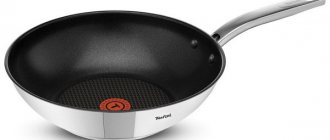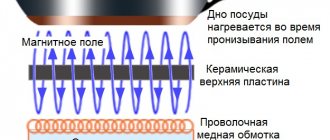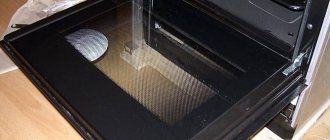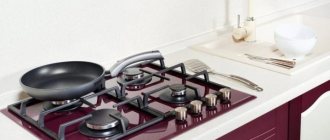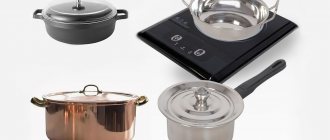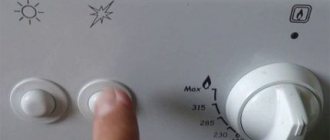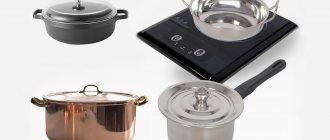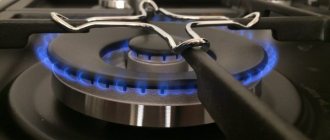Modern home appliance stores have a huge selection of stoves for every taste. However, buyers often wonder which stove to buy - gas or induction. Many people choose a gas appliance. It is more common to use, and gas is cheaper than electricity. However, if you start to understand this issue more deeply, the situation will no longer be so clear. In terms of convenience and quality of cooking, many people prefer induction devices.
Which stove is better - gas, electric or induction - we'll figure it out in the article.
How much gas does a gas stove consume?
This type of stove has 4 burners + 1 in the oven. Each of them has its own power, which according to GOST is measured in kW. All parameters of the burners are specified in the product passport and differ depending on the model and the country that produced it. The total power of the burners is 10 kW.
Gas is measured in cubic meters. m/hour. Find the sum of the powers of 4 burners + 1 in the oven, divide by the calorific value of the gas, which is 8–11 kW*hour/cubic meter. m.
For example, a device has 2 medium burners, 1 with a low burner and 1 with a high burner for gas consumption. After mathematical operations of gas consumption with a 4-burner stove, we get the result: (0.6 kW+2.6 kW+1.7*2 kW) / 8 kW*hour/cubic meter. m=1.2 cubic meters m/hour. This indicator should be indicated in the instructions for the stove.
If documentation is missing, take an average of 1.2 to 2.5 cubic meters. m/hour. When the stove operates for approximately 1 hour every day per month, the fuel consumption will be: 1.2 cubic meters. m/hour*30 hours=36 cubic meters m.
Reference. When calculating, it does not matter whether liquefied or natural gas is used.
The meter will calculate gas consumption as accurately as possible. The stove, unlike the column and other appliances that consume gas, consumes it to a minimum. To select a meter, contact specialists who will calculate the throughput of all installed gas appliances and select the desired type. If the meter is incorrectly selected, the gas fee will be much higher.
Which stove is better: gas or induction
For several decades, people have been trying to identify a leader among gas and induction cookers. As soon as new functional devices operating on blue fuel appear, the manufacturers of the latter immediately give their answer.
@content.abt.com
Competition in the household appliances market is constantly growing, which makes it difficult for ordinary users to choose. But today I will still try to determine which type of model is more profitable, more economical and safer.
Device
Before moving on to the comparative characteristics of the two types of stoves, I will briefly talk about the design of each of them.
A gas stove is a kitchen appliance that uses flammable gas as fuel. Comprises:
- housings (enameled steel);
- desktop with burner inserts;
- oven;
- ceramic or aluminum burners;
- shut-off valves;
- distribution pipelines.
An induction cooker is an electrical kitchen appliance that heats metal cookware by induced vortex flows created by a high-frequency magnetic field.
Its components:
- glass ceramic surface;
- touch control board;
- temperature sensor;
- power section;
- pulse regulator.
Convenience
There is an opinion that devices operating on the induction principle are superior to their gas counterparts in terms of ease of use. Let's figure it out.
During the combustion of a combustible mixture on heating equipment, a specific fat deposit is formed, which is very difficult to wash off (even with the help of modern cleaning products). Thanks to the smooth surface, induction hobs are easier to care for; you just need to wipe them with a damp sponge (no special household chemicals are needed).
@wonderfulengineering.com
The popularity of gas is explained by the uniform distribution of the source of instant heat, the ease of adjusting the intensity of the flame and its low cost. But here, too, models operating on the induction principle win, because they are controlled by an automatic system that regulates the heat supply and maintains the temperature until ready, which allows the housewife to do other things.
Conclusion: induction surfaces are more convenient to use.
Economical and safe
Despite the fact that gas equipment differs from its counterpart in its low efficiency, it consumes less electricity than any induction appliance. In addition, the latter has a more complex design and many different settings/functions, so it will cost the user three to four times more.
@f1.media.brightcove.com
But in terms of safety, blue fuel is inferior to its induction counterpart. Using the first implies a constant threat of gas leakage, which can result in poisoning or explosion. In the second case, there are no heat sources, which means that the hob always remains cold, therefore, it protects against burns from accidental touch and unpleasant odors from the combustion of food particles and oil.
Price
Prices for gas stoves range from one to five thousand rubles, but their counterparts cost several times more. To install induction models, you need to call a specialist and install a ventilation system. In a word, sheer expenses.
Dishes
Cookers with induction burners, unlike gas units, are very picky when choosing cookware. They only need cast iron, stainless steel or enamel utensils with a thick, smooth bottom and a cross-section of more than 12 cm, otherwise the oven simply will not turn on.
Functions
Gas heating devices (which cannot be said about their analogues) do not have such functions as child lock, standby mode, pause, or sound cooking timer.
How much electricity does an induction cooker consume?
One burner in an induction panel consumes about 1.5 kW/hour. How much electricity will be consumed monthly depends on the number of people in the family, the types of dishes prepared, and the frequency of operation.
There are some average values that are used in calculations. If you cook 3 times a day, two dishes for 15–20 minutes each, 20 min. x 0.025 kW/min. = 0.5 kW. Next, these kW are multiplied by the number of dishes and preparations per day: 0.5 kW x 2 x 3 = 3 kW (per day). For a month it will be: 3 kW x 30 = 90 kW. In money terms this is: 90 kW x 4 rubles. = 360 rub./month. (calculated approximately, since the cost of electricity in each region is different).
Attention! If electric stoves are installed centrally in an apartment building, then users are subject to a reduction factor on electricity bills. This is shown on the payment receipt.
Disadvantages of gas and induction panels
The biggest disadvantage of gas is the fire hazard of open flames and explosion hazard. When fuel burns, oxygen is consumed, soot and carbon monoxide are released. The panel can only work in conjunction with a hood.
If the device is adapted to work with main gas, additional equipment will be required to switch to liquefied gas. Incomplete combustion of fuel can lead to the creation of an explosive mixture in the room. Sometimes the electric ignition system fails.
When equipping your kitchen with a gas panel, be prepared to carry out cosmetic repairs every year. The walls of cookware over an open fire get a coating that is difficult to remove. Caring for the panel takes a lot of time. The gas contains an unpleasant odor; when it burns, a persistent characteristic odor is formed, signaling danger.
Special cookware is the main condition for the operation of an induction furnace. You can only use cast iron, stainless steel or enameled utensils with a thick, smooth bottom and a cross-section greater than 12 cm.
The induction cooker should be installed away from a microwave, dishwasher, or washing machine. The electronics of these devices are sensitive to the effects of electromagnetic waves. Magnetic keys and cards should be kept away from the panel.
Advantages and disadvantages of an induction cooker
Induction is a type of electric stove with a glass-ceramic hob. However, instead of cast iron heating elements, it has powerful induction coils.
With the inductive heating method, the current is generated from a high-frequency magnetic field (20-100 kHz). The work includes induction coils made of copper, which do not heat the burner: the heat interacts with the discs of the bottom of the cookware. The user sets the desired temperature, to which the dishes are heated, but the burner itself does not become hot.
Advantages of a stove with induction heating method:
- dishes and their contents heat up faster than on gas appliances;
- soot and soot do not form on pots and pans, surrounding furniture, and equipment located nearby;
- the panel is easy to clean - any dirt can be easily removed with a damp cloth;
- since the burner remains cold during operation, it is impossible to get burned on the panel;
- You can precisely set the heating mode;
- The panel turns off simultaneously with the removal of dishes, which saves electricity consumption.
Induction or gas stove, which is more economical? The answer is obvious - induction. And this is its main advantage.
But there are also disadvantages:
- Induction cookers are expensive. Repairing the panel and coils is expensive, and craftsmen who do it are not easy to find.
- You will need special dishes with a thick magnetic bottom.
- The glass ceramics from which the surface of the device is made splits from pinpoint impacts, for example, from a knife falling with the tip down.
- The device produces electromagnetic radiation that affects humans and devices. Therefore, the plates are installed at a distance of 50 cm from other devices. People with pacemakers are not allowed to cook with this appliance. Bank cards are demagnetized near the induction panel and smartphones are damaged.
Comparison of induction and gas stoves
It is quite difficult to compare these models, since cooking with gas is much more profitable than with electric counterparts. If you live in a modern house where only electric stoves are installed, then an economical option is to install an induction panel with 2 burners; this is quite enough to cook for an average family.
For example, to boil 2 liters of water on a gas stove, it will take no more than 10 minutes, an electric model will cope with the task in half an hour, spending about 1.75 kW/hour, and an induction panel copes with a similar task in 5 and a half minutes, costs for electricity will be no more than 0.34 kW/hour. The induction-type stove handled boiling best of all, but the gas stove is still the leader in terms of efficiency.
Convenience
Here, new developments have practically no equal: induction burners are equipped with special sensors that can recognize the presence or absence of cookware on the hob. As soon as the user removes the pan, the automation instantly turns off the current supply; in addition, smart burners heat only the bottom of the pan, determining its area.
Energy savings are obvious; the user can also set the time for cooking, for example, soup, and go about their business without interfering with the process, and when the countdown ends, the burner automatically turns off the heating zone. This is impossible with a gas stove. If you live in a country house where there is no gas connection, then it is more profitable to install an induction stove: it heats faster and turns off automatically.
Safety
In this regard, induction models are far ahead of their gas counterparts: for example, if you boil water from a kettle that the user has forgotten, no gas control will help here, the dishes will melt and there will be a fire.
In a similar case, nothing like this will happen with an induction cooker, because almost all models are equipped with automatic shutdown: if the user does not intervene in the process for an hour, the current supply stops.
Price
The power of induction cookers is much greater, although they consume no more energy than electric ones, but their price is still high. For example, Hansa BHI64383030 costs about 13 thousand rubles - this is the most affordable 4-burner hob. Its power is 3.5 kW, so it is suitable for users who live in houses with old wiring designed specifically for this maximum load.
It is also necessary to take into account such an important aspect as maintenance: gas models work for many years, and users never think to call a technician to inspect them, except in rare cases when the stove needs to be moved to another location. The induction hob requires routine maintenance by specialists.
Advantages and disadvantages of a gas stove
A gas stove is a familiar appliance to many. Nowadays, they are used when the house is connected to the gas main. There are many such houses in Russia. In addition, gas stoves are used in private homes, connecting the devices to cylinders.
Advantages of gas devices:
- are an order of magnitude cheaper than induction options;
- gas also costs less and is consumed more slowly than electricity;
- Any utensil can be used for cooking with blue fuel – you won’t have to change it when you buy a new device.
However, the number of minuses outweighs the pluses:
- The gas is explosive, so systems need to be regularly checked for leaks.
- If during repairs the stove is moved to a new location, this is considered an element of redevelopment that needs to be legalized by the gas service.
- To clean the work surface, use special products purchased from household chemicals departments. The panel remains hot for a long time, it is impossible to wash it right away, so food particles and grease dry out quickly. It will take effort to remove such stains.
- If there is no hood above the stove, soot will form on the equipment and objects located nearby.
What are the benefits of gas stoves and hobs?
A traditional gas stove is easy to install: the old appliance is removed from the room and a new one is installed in its place.
Attention! Only specialists from the gas service connect hoses to the stove.
The stove holds heavy pots on the panel, and the built-in oven stores pots/pans/ladles instead of a cupboard.
Each stove has a lid. If it is lowered and covered, for example, with a tablecloth, the stove becomes an additional work surface in the kitchen.
With today's wide selection of cooking appliances, housewives skillfully combine them. For example, they buy an electric oven and install a hob for daily cooking. This gas surface is compact in thickness, so it can be mounted on any countertop. There remains a space underneath where they make a cabinet with shelves and drawers. This is an ideal solution for small kitchens.
Hobs always have an aesthetic appearance. There is an option for any kitchen design - modern, high-tech, classic. Induction panels are easy to clean: they are wiped daily with a soft cloth, as they are most often made of tempered glass or glass ceramics.
The panel is an independent device; it does not have to be located above the oven. If there is no need, do not purchase an oven at all.
Features of gas stoves
Gas stoves can be either enameled or tempered glass. The latter will be somewhat more expensive than the former, but otherwise there are no differences from the old, well-known slabs. Only gas control and timer functions have been added.
Advantages and disadvantages
The main advantages are low price and economical use. Also, some people say that dishes cooked on gas are more tasty. Among the disadvantages are poor functionality, long heating time, and the possibility of leakage if there is no gas control.
Pros and cons of a gas stove
In addition to the above qualities of gas units, several more parameters can be noted that influence the choice. As already noted, the financial costs of operating gas stoves are lower. But this is only if there is a connection to centralized gas pipelines. Another advantage in favor of gas devices is the ability to use almost any metal utensils. Ease of operation also influences consumer choice.
The disadvantages include low efficiency, the constant presence of a gas smell in the absence of a hood, the formation of carbon deposits on the dishes and a rather unpleasant maintenance process (cleaning the grate, burners).
